Dr. Rebecca Gimenez: Barn Fire Issues & Mitigation
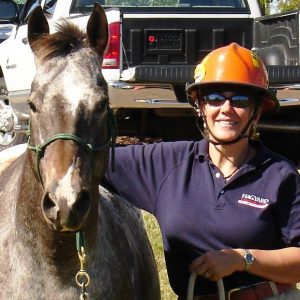
Dr. Rebecca Gimenez
Editor’s Note: Best Horse Practices Summit presenter Dr. Rebecca Gimenez trains veterinarians, firefighters, animal welfare officers, and horse owners in tackling incidents found in large animal rescue scenarios and situations, and how to create prevention solutions for their communities and facilities. She runs internationally-renowned Technical Large Animal Emergency Rescue.
Read more on evacuation preparation here.
Dr. Gimenez writes:
“FIRE” is a word that veterinarians, animal owners, and emergency responders do not want to hear. Many aspects of an equine facility can be considered fire hazards. Even though building a fireproof barn or property is not realistic, there are numerous measures that can be taken to dramatically reduce the chances, or mitigate losses in wildfire threats. Loss is not just limited to animal lives. People have died in these disasters as well, and there are dramatic economic impacts as well as loss of beloved pets and companion animals.
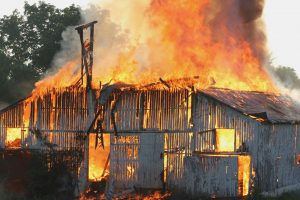 Myth No. 1
Myth No. 1
If you leave a halter and lead rope outside your horse’s stall, then a firefighter can halter him and lead him to safety.
We have all heard it. Who told us that myth? Where did they learn it?
The truth is that in most barn fires, by the time someone notices and attempts to respond, the fire has burned out of control and quickly consumed the building. There was no chance to get the horses out. And, incidentally, the flames didn’t kill the horses. The smoke did.
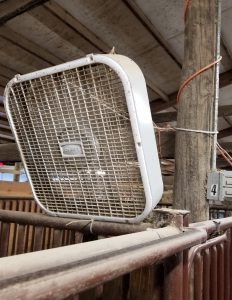
This house fan could easily spark a fire. It doesn’t belong in your barn, especially so flimsily attached.
Myth No. 2
Blindfold your horse to lead it from the barn or it won’t leave.
The movies have taught an entire generation to do the WRONG thing.
And, anyway, how many people have a blindfold handy?
Who of us can reach that high?
How many have actually tried it? If you DO try it, you will realize it takes precious seconds and many horses further panic. Others refuse to walk forward.
- Instead, how about teaching your horse to look to you as a leader?
- How about teaching your horse to lead in all types of stressful situations as a best practice?
As a rule of thumb, fires double in size each minute. The burning process follows strict rules of physics related to fuel load, ventilation, and oxygen availability. This means that usually by the time a flame is noticed, the fire department will not be able to get to the facility in time to save any people or horses trapped in the barn. You can expect the average barn to be fully “involved” (engulfed in flames) in the seven to 12 minutes that it takes for the fire department to be notified, respond to the location, and begin to fight the fire.
Why don’t we have a better idea of the number of barn fires affecting horses?
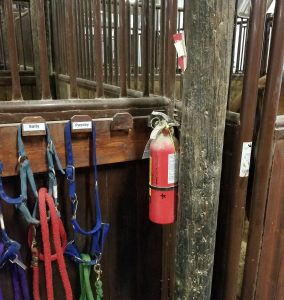
This extinguisher is too small and hidden to be effective in a barn fire
Many fires are not reported in the news – especially if no animals or people are killed, or low numbers of horses are killed. The news tends to report incidents where large numbers of animals, or one or more people, are injured or killed. Anecdotal data demonstrates much larger numbers of fires affect animal facilities which implies that the actual number of tragic deaths of horses in fires is much higher.
As an industry, have “ostrich syndrome” when it comes to barn fire preparation: We think it won’t happen to us. But it happens to beautiful, fancy, high-dollar barns as often as it does to race tracks and small, modest barns. Your education, race, wealth, or background doesn’t matter. What matters is this: What you have done to prevent and mitigate fire at your facility?
Prevention is enhanced with management, design, and emergency planning in concert with choice of materials, facility layout, siting of buildings, and ongoing maintenance.
I asked the National Fire Protection Association (NFPA), “Why are fires such a problem in horse barns?” Turns out fire service’s recommendations are partially or even wholly ignored by those building most horse facilities. As agricultural facilities, they don’t have to attend to the codes, even when many people come into the barn facility on a daily basis – including children.
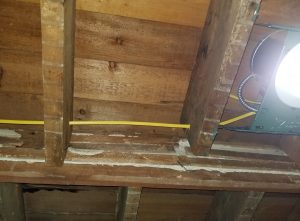
Electric wire belongs in a conduit, more visible and away from rodents.
Two crucial areas concern me: appropriate ventilation and planning for an optimal fire detection/alert/response method. It is all the prevention, folks. The DETECTION–ALERT–RESPONSE–SUPPRESSION cycle is proven to save those public buildings, residential homes, and private barns outfitted with the appropriate outdoor use smoke detectors, thermal rate of rise detectors, or even flame detectors plugged into an alert system (usually to a security company). These buildings are prepared for raising an immediate response from fire departments while a suppression strategy is initiated (automatic sprinklers are best). Where sprinklers aren’t possible due to expense, lack of water availability, or climate, then effort has to be pushed even more onto detection and alerting.
We often forget how much it takes to fight a fire where there are so many combustibles (hay, shavings, rubber mats, wood structures, etc.) in one place. The following example is of a recent horse barn fire. It reminds us just how flammable barns are. No horses died (they were outside at the time of the fire), but this situation gives us an idea of the sheer logistics involved in fighting a barn fire:
Question: What does it take to fight a barn blaze in the countryside, miles away from any municipal water supply?
Answer (from fire department):
- 12 hours (in August heat and humidity)
- More than 100 firefighters from 23 fire departments, the Red Cross, EMS
- Transportation of more than 200,000 gallons of water (about as much as you’d find in an average farm pond) to the fire site.
The fire caused an estimated $150,000 in damage and the owners lost 8,000 bales of hay.
Methods and best practices for how to configure animal facilities to mitigate fire spread and provide increased life safety for employees, owners and, of course, the horses are available. I’ll talk more about them at the Best Horse Practices Summit.
Specifically, animal housing and facility fires initiated onsite or by wildfire are tragic events that cannot be completely eradicated but can be greatly reduced by taking preventative measures. Many aspects of design, materials, building layout or siting, and management methodology, or even simple retrofits to existing animal facilities can affect outcomes. We need to look harder at the fire science and the complex reasons why we are rarely able to save horses trapped in stalls during barn fire conditions, so that we can improve the odds of saving them.
Read more on evacuation preparation here.
What do you do in your facilities to prevent and mitigate these scenarios? Do you practice a barn fire evacuation? If so, please directly e-mail me a copy of your plan at delphiacres at hotmail dot com and I will help you evaluate it (I call this a “sanity check”).

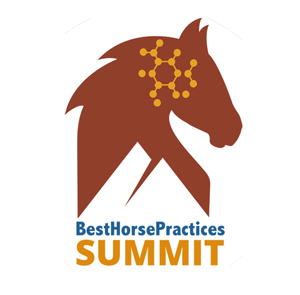
Feel free to contact me – directly.
Thank you to Cayuse Communications for working to educate people.
My new barn was fully involved in about 6 minutes and burned to the ground in about 30 minutes. Thankfully all my horses were in the pasture at the time, but everything inside was lost. If the horses had been stalled, there is no way we could have gotten them out in time even if they had been wearing halters at the time. We had one draft horse that actually tried to run into the barn in a panic. My suggestions would be:
1. Have a sturdy paddock or round pen where you could safely put the horses(our run-in shed and pasture was attached to the barn) a safe distance from the barn. The chaos of firefighters, hoses, ladder trucks and lights during a night fire were frightening to the horses.
2. Keep spare halters and leads in another location.
3. Store your hay and bales of shavings in a different building if at all possible. Ours was an electrical fire, but once the hay caught fire, there was no stopping it.
Judy – I am so sorry to hear of the loss of your barn – thank GOODNESS your horses were okay! I was just consulting at a barn in Atlanta the other evening and talking about these very facts – there is NO time to do what people THINK they can do under emergency situations.
PLanning for evacuation requires you to PRACTICE your plan to find the holes in it – too.
Thank you for sharing your experience… very scary!
Rebecca
Excellent article. I think 7-12 minutes response and set up could be correct in a city, but in most rural areas, it seems fire departments are volunteer only. This means that, once the call goes out, the responders have to leave their jobs, homes, daughters baseball game, and drive to the station. In my area (when I lived in the country), the response time was hopefully “under 15 minutes” but often longer, then responders had to hook up and begin fighting the fire. This also meant that the gate to the property was open, the address was posted very clearly to be seen by flying fire rigs, there were no range cattle on the road, the address was correct, and the call came in over a land line and could be located. at one famous fire in our area, the call came in by cellphone which meant it was received in another county, and the dispatcher was unclear on the location. I passed the fire rig heading in the wrong direction. They had to turn around and retrace their route to the point where they went off-course. What an embarrassment. Fortunately it all worked out fine and didn’t involve lives. Another thing we were taught by fire departments is that when you call in a fire be sure to say its a stable and lives are at risk. FDs respond differently to a barn full of hay than to a stable with horses in it.